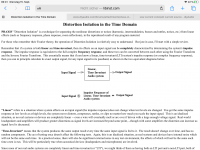Seems to me if capacitors sound different to multiple skilled listeners
Big 'if'.
I am talking from point of view 'how to find a difference'.What is the right result?
I believe caps are more different than it was seen in the article.
But if he intentionally have chosen this setup with usual for studios opamps (some 'standart setup') - then ok. Then we clearly see that there is almost not difference between different el. caps.
So he proves that el. caps are almost the same in some conditions (large enough capacity). He is of cause not wrong here. It is a right result.
Last edited:
It is an important result. It means that in the conditions that the capacitance is large enough for the purpose, distortion can be disregarded.
Exactly the same result Douglas Self came to with lots of measurements.
Jan
Exactly the same result Douglas Self came to with lots of measurements.
Jan
Billions of people worldwide might not agree with this 😀
they can disagree all they want, truth is not by the number of believers....
As Anatole France once remarked about an issue in French politics: Even if 50 million people believe a stupid thing, it still is a stupid thing ;-)
Jan
Jan
Even if 50 million people believe a stupid thing, it still is a stupid thing ;-)
It is normal for all humans to believe some stupid things. They are less likely to do it in their field of expertise (if they have one), but they still do it in other areas.
It is also normal for humans to be far, far better at seeing other people's faults than at seeing their own faults. Humans are virtually blind to the latter. So, complain about others if you want, but probably wise not to feel to smug that you are better. That goes for all humans.
Cyril Bateman's test was much more interesting...
https://www.diyaudio.com/forums/parts/151392-electrolytic-capacitors-120.html#post5478553
https://www.diyaudio.com/forums/parts/151392-electrolytic-capacitors-120.html#post5478553
It is normal for all humans to believe some stupid things. They are less likely to do it in their field of expertise (if they have one), but they still do it in other areas.
It is also normal for humans to be far, far better at seeing other people's faults than at seeing their own faults. Humans are virtually blind to the latter. So, complain about others if you want, but probably wise not to feel to smug that you are better. That goes for all humans.
+100
But highly "trained" believers are exempted. 😉The Gospel according to Mark
The large values are clipping distortion from the op-amps, as mentioned in the article. For some reason it is somewhat worse with capacitors, presumably because high-pass filter overshoots make some op-amps clip a bit harder.
That made sense until revisiting figure 6, which shows no evidence of overload at any frequency at +20 dBu. Something about the test protocol?
I see you are a firm Believer from the Church of Run In / Burn In 🙂What?? ..... How about run-in?? After 100hrs of run-in, any changes?? ...... Nothing.....
Maybe 6 Moons or some other Audiophile Approved site cares to publish these results.And then, no citations, no references nothing......You call this paper???
Not holding my breath though, they lack the required subjective hyperbolic poetic effusion needed. 🙄
and i find PRR's argument about cost justifications when thousands upon thousand caps were involved the sanest argument thus far....
That made sense until revisiting figure 6, which shows no evidence of overload at any frequency at +20 dBu. Something about the test protocol?
A 31-tone test signal can have a sqrt(31) times worse crest factor than a single tone.
- Home
- Design & Build
- Parts
- AES: Evaluating Electrolytic Capacitors Specified for Audio Use
